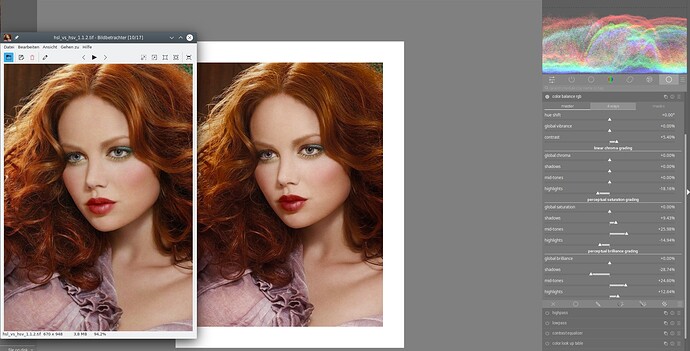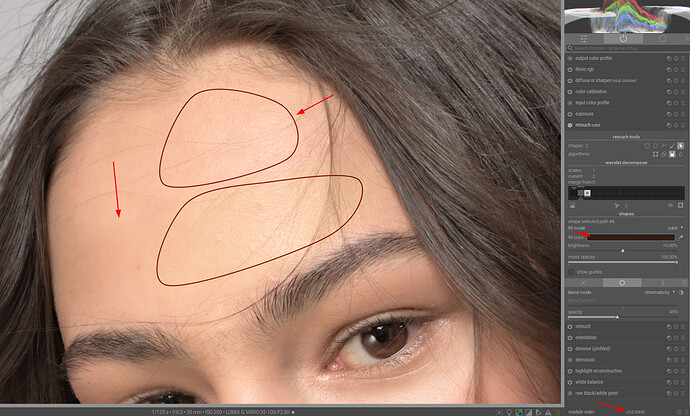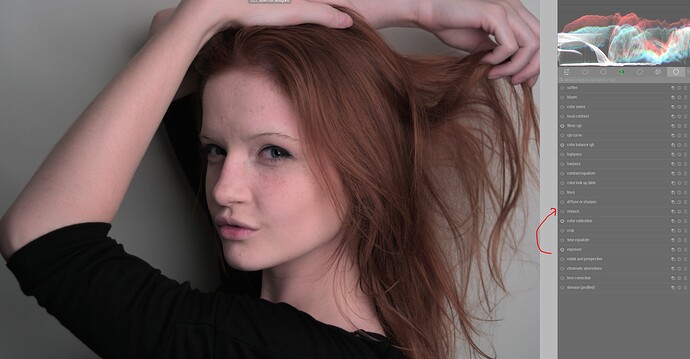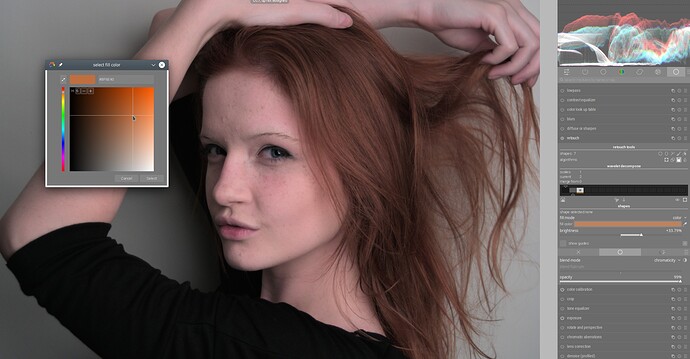Thanks for your explanation. It might be more interesting for @EsTaF since he was wondering where the setting is. I think the two older topics I linked also contain some nice statements about why it’s gone. For my part I’ve anyway never used it.
Thank you Boris, very nice video.
I noticed very often you re order the stack (so the next module is not influenced by the adjustment already done). I am curious - if this re ordering is not done - are you noticing significant change? I am asking because I read somewhere darktable 3.8 user manual - module order that in general DT would handle the order well and rarely reordering of the module is needed.
Also - in some other videos I have seen that photographers adjust a tiny bit the eyes - like size. Is this possible in DT? I tried the liquefy module but it always pushes in one direction. Not sure if I am doing something wrong.
I understand this maybe controversial and even if possible can easily go from barely noticeable to very wrong.
Ctrl click on the arrow head this toggles from radial in to radial out to push…
Examples shown in the module…its a pretty big hog on resources so it can be slow
https://docs.darktable.org/usermanual/3.8/en/module-reference/processing-modules/liquify/
Yeah. Too bad dt can’t process video. I mean log video. So I process video easily by throwing the program tiff files from Davinci. It’s a pity, because I can’t use all power of the program - sharpening, grain manipulation. In filmic rgb I have to turn off iterations of image processing and adding noise to light. The hald file just can’t handle all the retouching.
But this is another topic, not related to this branch, because the work with video is already and support for output boards (deklink the same) and support for control panels (all these balls for adjustments). And in general - this is another topic.
Thank you! exactly what I was looking for!
As usual I am a little lost but if you are referring to using DT to edit tiffs spit out from log video and correcting that in DT with a LUT like you would a video editor I think you will likely need to move the LUT module and not use it where it is…even then I am not sure exactly where or of the results. You would have to expt. Then maybe depending on what you typically end up with you might find that filmic might not even be what you would want to use…its just a global tone mapper
In any case you might find some of the discussion from here touches on this aspect of DT…
Nah. You need a separate paint program. From developing the video to interpreting it in rec.709/etc. At the level of coloring, as Darktable, only “baselight” ( FilmLight | Products | Baselight ) level programs can perform - proprietary of course.
Ok. The following case is a good task to think about:
With Retouch module I would like to improve/change (among other changes) color tone of skin.
But, the retouch module comes hierarchically before the white balance (color calibration module).
I’m thinking how to replace this point in the darktable
Один человек подсказал мне вариант Park. Autumn. day. Beauty. - #21 by priort But still, that’s not it.
Well, in general, if we proceed from the mechanism of color balance rgb tools, then yes - this option is analogous to the work of the shift of lightness relative to saturation in hsl vs hsv. yes, Boris. Thank you. Didn’t think of that, although I knew it works that way. Closed.
Ideally, you can do all this without a mask.
Who’s interested.
source:

hsl vs hsv:
hsl_vs_hsv_1.1.2.tif (3.6 МБ)
DT/color balance rgb with sat mask
21a7510601879411d0afdac76128440d.tif (1.3 МБ)
xpm of src
21a7510601879411d0afdac76128440d.jpeg.xmp (3.4 КБ)
No. It’s nothing. It’s all regulated. The result is more important. Looks like my topic is off-topic. I’m closing it.
This is a very interesting point.
This is the default order and sample done from the left part of the forehead (but it looks quite darker on the picker) as you mentioned because the module is before color calibration. Otherwise - it still blends okay. But I should admit - your eyes are much better trained than mine.
bottom patch is from roughly the same area and the color under the picker looks much better. But I did take it with the modules re arranged (this is why it does not look that nice)
When the modules are reordered the bottom patch is more in line.
To my eyes - #1 (default order top patch) and #3 (custom order bottom patch) look close (I can’t say I am improving it as the goal was to see it).
I can see the difference but it is more because I know it is there (so I am looking for it).
I am curious Boris - is there summary or “cheat sheet” in what cases you are opting for reordering the modules? I may need to re watch the videos but if my question is not a big trouble I would like to learn a bit more.
I am predicting Boris will say there is no list just experiment… ![]() having said that this section of the manual give some good tips about processing and if you think of DT as showing you the end result of a serial chain of modules with each taking its input from the output of the previous one you can make some educated decisions. Many of those are about moving things after filmic or moving artistic edits after the overall basic edit is completed and not where the multiple instance will be created…
having said that this section of the manual give some good tips about processing and if you think of DT as showing you the end result of a serial chain of modules with each taking its input from the output of the previous one you can make some educated decisions. Many of those are about moving things after filmic or moving artistic edits after the overall basic edit is completed and not where the multiple instance will be created…
https://docs.darktable.org/usermanual/3.8/en/overview/workflow/process/
Another example.
This is how the photo looks before white balance:
After the white balance it looks like this:
The skin color is too reddish and I can’t get a good sample out. So I have to do the color correction in the custom way.
First I move the retouch module over the color calibration, because I want to make the changes after the white balance:
Then I choose a user-defined color to neutralize/cover the reddish:
Then I mask the skin areas in question and correct the color there:
If I had done this without reordering the modules, the change in skin color would have been distorted by the white balance of the color calibration module and I would have turned the model into a character from the movie “Avatar” ![]() :
:
@priort already answered well - there are no rules or “typical” examples for this. It always depends on the intention and the photo.
The most important thing is to understand how the pixelpipe works and what happens to the colors and contrasts in certain places and then think about where it makes more sense to make a certain change.
Basically, the given order is already well thought out and rarely needs change.
So if I understand the situation correctly, you need to change the module order because you use an absolute colour in the retouch module, which will be changed by the color calibration module. If you could have done the same thing by specifying a relative hue shift, you wouldn’t need to reorder the modules?











